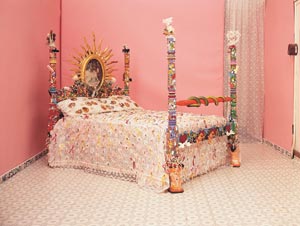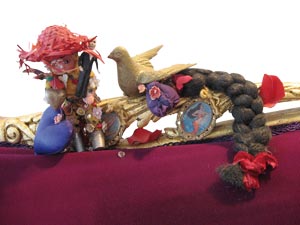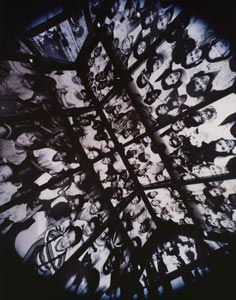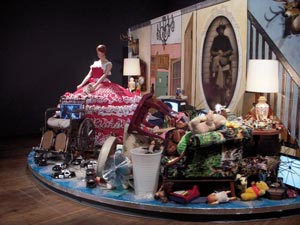The symbolic dimension of materials inPepón Osorio’s work
The work of the Puerto Rican Artist, Pepón Osorio, replaces and re-produces on an artistic level the logic of memory. For him, as for the Caribbean individual in general, memory is a necessary instance, essential for cultural survival. The past is always susceptible to being converted into memory. And what is the human being’s vital experience but a continuous progression of events that are incorporated in the past? Man experiences his existence as a recollection of that that what was, of that that just was; and memory, with its selective and re-creative logic, is this process’ natural support.
Osorio is one of those artists that operates directly with social fabric. He directs his look towards the conflicts of the most disadvantaged individuals and groups, increasingly broad and numerous dark spots, which result from the asymmetry in human relationships and the distribution of power and property within the man made model of society. He sounds out the reality of Latino immigrant communities in the States: extracts stories of violence, abandonment, nostalgia, misery, heroism and deep and infinite love, which feed his creative universe. This artist’s merit lies in having the required sensitivity to address issues of an essentially anthropological nature and to select, amongst all possible options, an aesthetic strategy capable of sharply and fully expressing them.
 However, having emigrated from his native Puerto Rico to the United States when only eighteen years of age, and living there as a social worker with the poorer classes, turned Pepón into a main part of his own epistemological research. So, unlike traditional social scientists, the Puerto Rican does not try to take a critical distance nor examine externally that which is of his interest, quite the opposite: he uses his life acquired experience, –that of black, Puerto Rican, immigrant, artist and social worker living for years in New York’s Bronx–, as a significant source of useful and first hand information.
However, having emigrated from his native Puerto Rico to the United States when only eighteen years of age, and living there as a social worker with the poorer classes, turned Pepón into a main part of his own epistemological research. So, unlike traditional social scientists, the Puerto Rican does not try to take a critical distance nor examine externally that which is of his interest, quite the opposite: he uses his life acquired experience, –that of black, Puerto Rican, immigrant, artist and social worker living for years in New York’s Bronx–, as a significant source of useful and first hand information.
One of his classics, En la barbería no se llora (At the barbershop you don’t cry, 1994), suggests in an authentic manner, originating from Osorio’s childhood memory –when he was taken by his father for the first time, to cut his hair–, enriched by the artist’s life experiences in an essentially macho community. All this helps Pepón to design a sui generis space: red velvet-covered seats, the roof covered with a screen printed design of enlarged sperm photographs, monitors with men crying while telling their life story, pictures of muscular torsos and other elements, some explicitly phallic, all part of the place’s ambience. This proposal calls for reflection regarding the Latin stereotype of masculinity, based on physical strength, sexual prowess and economic power, while the aesthetic overloaded with household decorations and “feminine touches”, presents alternative models of masculinity where men may cry.
As he demonstrates En la barbería... Pepón takes the product of his peculiar research approach to the art world and from there he forms it “[...] to the voices, aspirations, fears, disappointments, frustrations and humor of the common man”[i], always defending the place of society’s most vulnerable (women, children, blacks, prisoners, homeless, murdered, oppressed ...), and extolling through artistic reconstruction their particular life stories. This tendency turns Osorio’s work into in an important site for popular demand[ii] in midst of the so-called “high culture”.
The elements of his installations also participate, reveal and deconstruct certain ethnic and cultural stereotypes, almost always linked to power relations and the rigid schematic way in which the region has been seen by the West. His method is exaggeration, “but, while these images are ridiculed by his excesses, he also embraces them. The cliché is revealed as a mask, a disguise that hides not only life’s frustrations, but also stories of domination and subjugation”.[iii]
 All this takes shape in his works, which document issues central to the Latino and Puerto Rican communities in the United States, namely: violence (Escena del crimen- Crime Scene, 1993; El cab- The cab, 1997); discrimination and conflicts of race, gender , class and/or nationality (Maria Cristina Martinez Olmedo, DOB, 27/3/89, 198; El velorio- The Wake, 1991; En la barbería no se llora; Nana para una madre- Nana for a mother, 1998; Juicios y disturbios- Trials and riots, 2004; Anima sola- Anima alone, 2008); family and home problems (No me arrepiento- I have no regrets, 1988; A mis adorables hijas- To my darling daughters, 1990; Insignia de honor- Badge of Honor, 1995; Las gemelas- The twins, 1998; Nana para una madre, La casa de Tina- Tina’s house, 2000); identity, and personal and historical memory (La bicicleta- The Bicycle, 1985; La cama- Bed, 1987; TKO, 1989; El chandelier- The chandelier, 1988; Transboricua, 1999; La casa de Tina).
All this takes shape in his works, which document issues central to the Latino and Puerto Rican communities in the United States, namely: violence (Escena del crimen- Crime Scene, 1993; El cab- The cab, 1997); discrimination and conflicts of race, gender , class and/or nationality (Maria Cristina Martinez Olmedo, DOB, 27/3/89, 198; El velorio- The Wake, 1991; En la barbería no se llora; Nana para una madre- Nana for a mother, 1998; Juicios y disturbios- Trials and riots, 2004; Anima sola- Anima alone, 2008); family and home problems (No me arrepiento- I have no regrets, 1988; A mis adorables hijas- To my darling daughters, 1990; Insignia de honor- Badge of Honor, 1995; Las gemelas- The twins, 1998; Nana para una madre, La casa de Tina- Tina’s house, 2000); identity, and personal and historical memory (La bicicleta- The Bicycle, 1985; La cama- Bed, 1987; TKO, 1989; El chandelier- The chandelier, 1988; Transboricua, 1999; La casa de Tina).
In general, these installations and sculptures, -often enriched with the inclusion of new media such as video-, consist of large collections of elements of heterogeneous condition, origin and meaning, which are attached as decoration around an object (La bicicleta, La cama, TKO, A mis adorables hijas, El chandelier ...) or situation (El velorio, Escena del crimen, En la barbería no se llora, Las gemelas, Insignia de honor, Juicios y disturbios...).
The way in which these elements are added to the central “axis” and especially how they transform and subvert its nature, significantly relate Osorio’s modus operandi with that of ready made and the surrealist object‘s concept. At this point it’s worth remembering At the barbershop..., or point out another much more recent piece, Lolo (2008), in which a pair of sandals are completely covered with hundreds of pins, prickling even the digital image of the feet that wear them.
The final touch in Pepón’s proposals is generally provided by joining the field of action. This can happen through a performance, as confirmed in his earlier works (La bicicleta is part of the performance Cocinando- Cooking; El chandelier, of No me arrepiento)[iv], or by full insertion in reality (En la barbería..., El cab, La casa de Tina), where the installations provide for the spontaneous involvement of the viewer outside of the gallery’s limited and sacralizing space. Osorio himself has publicly insisted that his main concern is that the works return and integrate into the neighborhoods where they came from.
In this sense, La casa de Tina (also known as “Home visits”), a itinerant piece whose insertion in reality is really peculiar, as it travels from house to house in the same way that certain saints in procession, and lives together with its residents for a minimum one week period. However, what is moved from house to house is not a religious representation but a small-scale reconstruction of the house of a lady whose home was destroyed by fire. The model, made with help from the descriptions of its former dwellers, tries to recreate as truthfully as possible the events of the night of the incident and its devastating impact on the place and those who inhabited it. So Osorio, on the one hand, makes the event is known and mentioned in many areas; and on the other, reflects on loss, memory, instability and how material goods determine people’s lives.
 As I noted previously, the components of Pepón’s works refer to the everyday world of the Puerto Rican and Latin people, in particular through those elements that shape their existence and influence in their identity’s formation. Although the range of objects included is vast and extremely diverse, namely portraits, images of saints, velvet, silk flowers, beads, plaster or plastic figurines, lights, small flags, posters, badges, souvenirs, tissues, and other similar... often these have one thing in common: they have been mass produced for a low-income mass market, and upon being removed from their usual contexts and re-contextualized load up with new meanings and an aura of authenticity inherent to all work of art. The appropriation and change of status imply then a de-automation of the manner in which they are commonly perceived and, therefore, puts them on speaking terms with the viewer and communicate something beyond their ordinary capabilities. In this manner reaching new expressive possibilities: moving from denotation to connotation, from literalness to the metaphor, from the banality of everyday life to the artistic text’s tropological density.
As I noted previously, the components of Pepón’s works refer to the everyday world of the Puerto Rican and Latin people, in particular through those elements that shape their existence and influence in their identity’s formation. Although the range of objects included is vast and extremely diverse, namely portraits, images of saints, velvet, silk flowers, beads, plaster or plastic figurines, lights, small flags, posters, badges, souvenirs, tissues, and other similar... often these have one thing in common: they have been mass produced for a low-income mass market, and upon being removed from their usual contexts and re-contextualized load up with new meanings and an aura of authenticity inherent to all work of art. The appropriation and change of status imply then a de-automation of the manner in which they are commonly perceived and, therefore, puts them on speaking terms with the viewer and communicate something beyond their ordinary capabilities. In this manner reaching new expressive possibilities: moving from denotation to connotation, from literalness to the metaphor, from the banality of everyday life to the artistic text’s tropological density.
Kitsch therefore takes on an unusual dimension in these installations, since the displayed objects are no longer banal copies becoming unique pieces that bear another value: their ability to register and evoke individual and collective tales, often related to the everyday life of their lost homeland, now so distant and different to continental life. Osorio does not make kitsch an insolent glorification of bad taste, or a cynical false worship, rather, on one hand, the way to channel the their homeland’s nostalgia, and secondly, the opportunity to aesthetically represent popular class’ will, so close to bricolage, in which you try to exorcise the scarcity in which one lives with an apparent and futile abundance, using the few resources available, in open defiance of traditional aesthetics and the historically legitimized concepts of beauty and elegance. This mask, which simulates a nonexistent joy, connects up with the carnivalesque notion, and the load of subversion and resistance it contains.
An appropriate example in this regard is El chandelier,[v] a piece for which Pepón was inspired by the chandeliers seen in some Latino homes. For these families the “spiders” were a glamorous object amid the hardship imposed by everyday life. The artist decorated his with kewpie dolls –plastic beauty queens–, pearls, plastic candles, glass bead garlands, plastic palm trees, red bells, plaster saints, plastic nails... All this and more was added to an originally baroque object, in order to achieve an alleged abundance and homely comfort, ultimately illusory. With this accumulation around the light fixture, Osorio demands attention to an aspect of Puerto Rican society: the fact that it worships its Spanish roots –the lamp’s model aesthetically identifies with Europe– and looks down on the folk and African traditions of their heritage. Dominoes, black children and other similar items included, symbolically represent those components omitted from the history of Puerto Rican culture.
However, not in all his installations the critical edge is reached by accumulations. Sometimes, silent sobriety results to be more consistent aesthetic solution. This is the case of Juicios y disturbios, that presents and condemns racism in the U.S. justice system. In it, Osorio reproduces a real size courtroom in the center of which he places, inside a glass-enclosed space, a video projection of the story of a teenage African-American who spent a long time as an adopted child. The realism of the piece becomes obvious, which attempts to capture the sobriety and aseptic atmosphere of the places where legal issues are resolved and civil law is confronted by practical existence. This sensory contrast is achieved formally by the contrast between the cold neutrality of the room and glass-enclosed space, in which in addition to audiovisual testimony, items such as furniture, utensils and clothing, are shown, openly alluding to a domestic universe.
 But no matter how he does it, through agglomerations or in more sober proposals, the truth is that Pepón’s installations, from the symbolic dimension of the incorporated materials, demand and question the common man tied up with the daily tragedies, subject of micro-utopias, postponed hopes and conflicts of identity. In them, the artist voluntarily relinquishes great speeches, collective meta-tales and abstractions, in order to approach and document private facets, real human beings, those who are not a concept but live and die, that suffer from loneliness and seek happiness without finding it; that believe, suffer and lose faith. Those who cannot be ignored because they are us, our parents, our children, our friends.
But no matter how he does it, through agglomerations or in more sober proposals, the truth is that Pepón’s installations, from the symbolic dimension of the incorporated materials, demand and question the common man tied up with the daily tragedies, subject of micro-utopias, postponed hopes and conflicts of identity. In them, the artist voluntarily relinquishes great speeches, collective meta-tales and abstractions, in order to approach and document private facets, real human beings, those who are not a concept but live and die, that suffer from loneliness and seek happiness without finding it; that believe, suffer and lose faith. Those who cannot be ignored because they are us, our parents, our children, our friends.
Looking for traces of his own history in the most ordinary and devalued objects and images, Osorio tries to recreate their cultural subjectivity as well as their community’s. With the art’s resources he achieves something impossible from any other field of the humanities: record and preserve with full vitality all that which the Caribbean individual has been losing with inexorable passage of time, the integrity of his being, and he prescribes memory as the most effective way of healing this illness.
During his career, which already covers almost three decades, Pepón has won a very prominent place in the international art arena. Not only due to the formal excellence that distinguish his pieces, but by the conceptual density he stamps on them, which has its cornerstone in the careful selection and organization of the materials. However, although these materials may refer and document peculiar phenomena of Caribbean culture, the interpretations cannot be reduced to the realm of our region. On the contrary, his installations scrutinize, problematize and record the life experience of the contemporary individual, and in this quest lay their universality.
April 2011
[i] JULIA P. HERZBERG: “El ritual en el performance”. En JORGE FERNÁNDEZ ERA (editor), comp.: Integración y Resistencia en la era global. Evento Teórico de la Décima Bienal de La Habana, Centro de Arte Contemporáneo Wifredo Lam y Artecubano Ediciones, La Habana, 2009, p. 252.
[ii] The popular understood as excluded as subsidiary: an unrecognized and unpreserved heritage, while it represents those to whom a place and a voice in history has been denied.
[iii] KELLY JONES: “Oración doméstica”.En Con to’ los hierros. A retrospective of the work of Pepón Osorio, El Museo del Barrio, Nueva York, mayo 2 - agosto 4, 1991, p. 31.
[iv] The performance is a recurrent element in Osorio’s first works, who along with the dancer and choreographer Merian Soto, his professional and life partner, conceived a series of actions that take place around their installations. This dynamic interaction between both genres maximizes the documentary significance of the first and reveals the mnemonic effectiveness of the latter.
[v] This lamp was made to form part of the performance No me arrepiento, told through slides, videos and dance, the life of Maria Aponte, a Puerto Rican working woman from the Bronx. El chandelier is one of the few luxuries she can afford. The story deals with the life of the protagonist in two distinct entities: her fantasies and the harsh reality that surrounds her. The first defined the novellas and soap operas; the second, taking care of her children, her job in a textile store and two men: a terrible husband and a loving taxi driver. At the end of the story, she decides to leave them both to enroll at City College and restart her life. However, looking into her past she told her best friend: "Sandy, I don’t regret anything."
Related Publications

How Harumi Yamaguchi invented the modern woman in Japan
March 16, 2022












